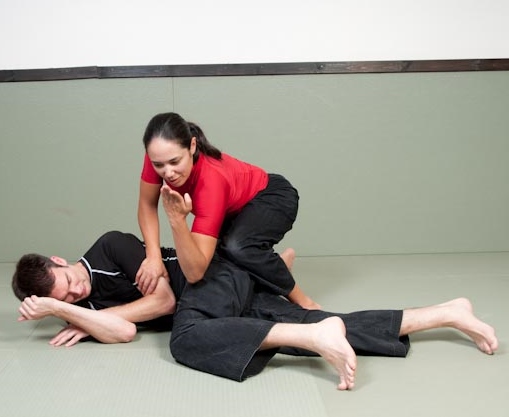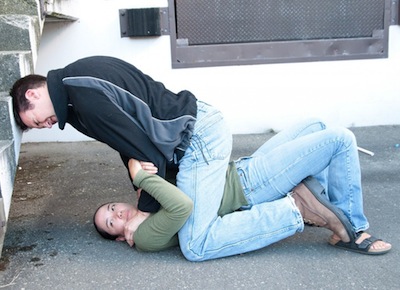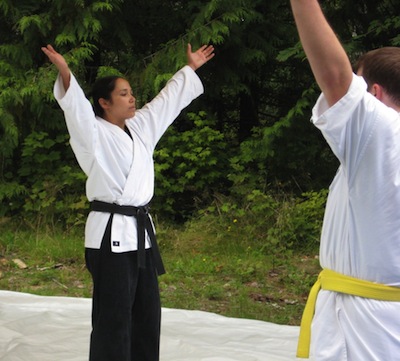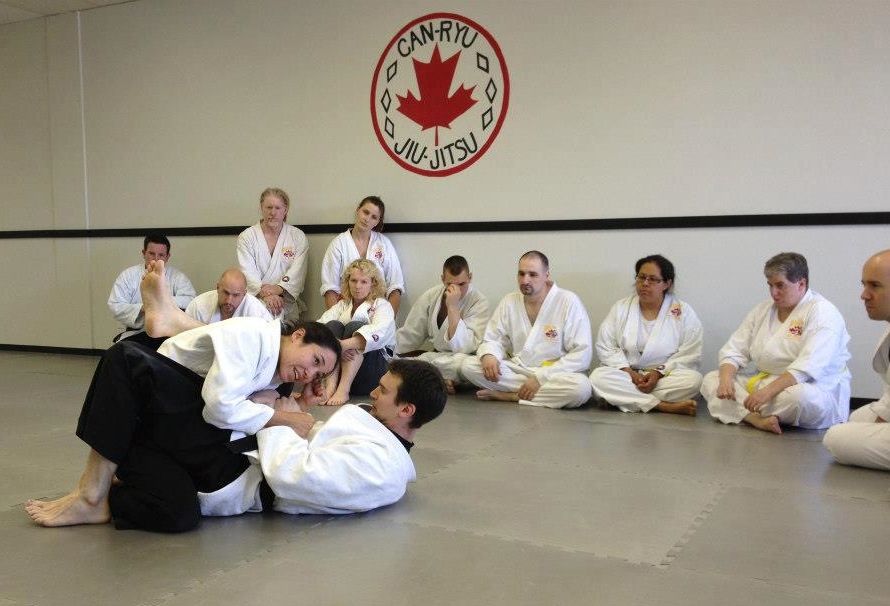The Overload Principle As Applied to Nerve Motor & Pressure Points
 Our style of Can-ryu Jiu-jitsu was created incorporating the PolicePressure Points System, a set of nerve motor and pressure points specifically chosen by Professor Georges Sylvain (our style’s founder) for their ease of use and effectiveness for law enforcement. There are a number principles that are taught related to their use to make the system’s application more effective. One of these is the “overload principle.” (more…)
Our style of Can-ryu Jiu-jitsu was created incorporating the PolicePressure Points System, a set of nerve motor and pressure points specifically chosen by Professor Georges Sylvain (our style’s founder) for their ease of use and effectiveness for law enforcement. There are a number principles that are taught related to their use to make the system’s application more effective. One of these is the “overload principle.” (more…)
My Approach to Teaching Martial Arts Seminars
Martial arts seminars have unique characteristics that differentiate them from standard ongoing classes in a school or club atmosphere. They are usually not your own students who will benefit from building on the knowledge base you offer over time. They may not even be from the same style as you, or even the same martial art. As such, I take a different approach to teaching them so that students make the most of the experience.
Home Strength Training Workouts for Martial Artists
As a complement to my martial arts training, I like to do cardio and strength training workouts at home to break up the writing work I do at my desk during the day. I run 3x a week, sometimes with sprint intervals, sometimes wihtout, but usually I do one 5k, one 8k and one 10k each week. As for strength training, I have two full-body workouts, one with a stronger emphasis on upper body and one with a stronger emphasis on lower body. These are workouts that only require a kettlebell (I use a 20lb one), some hand weights, a bench or small table, and a mat or carpeted area. Here is my home workout area in my basement:
No Do-overs: The Benefits of Training through Your Mistakes
 Having taught martial arts for nearly two decades, you come to notice certain learning habits people have that come from societal influences. For example, in Western society, people have don’t feel comfortable “failing” at something. When they attempt to do something, they want to do it as close to perfection as possible, which influences the way they practice a skill.
Having taught martial arts for nearly two decades, you come to notice certain learning habits people have that come from societal influences. For example, in Western society, people have don’t feel comfortable “failing” at something. When they attempt to do something, they want to do it as close to perfection as possible, which influences the way they practice a skill.
In Jiu-jitsu, some will start a technique then stop half-way through as they realize they’re not getting it quite right. If I let the student keep doing this, it would be entirely possible to see that student stop and re-start a technique over and and over without actually getting through it once before the class is called to see the next technique. Another way the unwillingness to fail can manifest is when a student either asks lots of detailed questions, or spends a lot of time talking about it, analyzing how it’s supposed to work, etc. These types will spend so much more time talking about it, fooling themselves into thinking that simply talking about it will make them better at it, that they don’t spend as much time practicing it. These types strategies for avoiding looking foolish or “failing” at a technique can hurt one’s mentality towards self-defense, as well as one’s development as a martial artist. (more…)
My Life as a Martial Arts Instructor & School Owner
A martial arts friend and colleague of mine sent me an email yesterday to wish my happy Mother’s Day. He said, “This may seem weird, but I wanted to wish you a Happy Mother’s Day. Not sure if you think about it this way, but you are truly a mother to your dojo.” It was the nicest thing I heard all week.
Finding the Stillness in Movement
 A few weeks ago, I was teaching a class in which I had students working on their boxing punches while moving forward and backward in a chasing/retreating drill.
A few weeks ago, I was teaching a class in which I had students working on their boxing punches while moving forward and backward in a chasing/retreating drill.
In self-defense or live training exercises like sparring, it is rare that you would get to hit a completely static target unless you managed to stun or distract the person first. That’s why it’s important to practice target tracking and this drill covers one particular aspect of it. It allows you to practice striking while your target is moving backward or while you yourself are backing away for whatever reason. (more…)
How to Hold Your Hands in Guard
There are a lot of different martial arts out there with a lot of different styles of hand positions that are used as their main fighting stances. The hand positions that are adopted are generally developed around the goals of the art. So in determining how you should hold your hands, you should keep this in mind. (more…)
Principles vs. Prescription: An Adaptive Approach to Self-Defense
 In my book, When the Fight Goes to the Ground, there are chapters detailing a variety of ways to defend against specific types of ground combat situations, from hold-downs and submissions to kicks to the head and knife attacks. We demonstrate each move in detail, which might lead one to believe that our goal is to provide a form of ground defense that is no more than a “if this, then that” type of prescriptive approach, when it is quite the contrary in reality. While I do go into detail about true self-defense being adaptive, and that the “techniques” I show for defending against various situations are only to serve as examples of the principles in action, it is difficult to make this point clear to readers. The less experienced are more likely to simply take the examples and practice them alone, rather than fully explore the principles behind them. (more…)
In my book, When the Fight Goes to the Ground, there are chapters detailing a variety of ways to defend against specific types of ground combat situations, from hold-downs and submissions to kicks to the head and knife attacks. We demonstrate each move in detail, which might lead one to believe that our goal is to provide a form of ground defense that is no more than a “if this, then that” type of prescriptive approach, when it is quite the contrary in reality. While I do go into detail about true self-defense being adaptive, and that the “techniques” I show for defending against various situations are only to serve as examples of the principles in action, it is difficult to make this point clear to readers. The less experienced are more likely to simply take the examples and practice them alone, rather than fully explore the principles behind them. (more…)
Jiu-jitsu Sensei’s Top 10 Posts on Development in the Martial Arts
 If you read our blog regularly, you probably know that we are strong proponents of personal development in and through the martial arts. Learning self-defense and getting/staying fit are the main reasons most students join us, but the ones that stay over the long term usually find other less obvious benefits that seep into them over time through their training. Today, we’re going to feature the top 10 articles related to personal development in and through the martial arts in the history of our site. Here they are below. Enjoy!
If you read our blog regularly, you probably know that we are strong proponents of personal development in and through the martial arts. Learning self-defense and getting/staying fit are the main reasons most students join us, but the ones that stay over the long term usually find other less obvious benefits that seep into them over time through their training. Today, we’re going to feature the top 10 articles related to personal development in and through the martial arts in the history of our site. Here they are below. Enjoy!
1. 3 Methods for Learning Martial Arts More Efficiently and Effectively.
2. Black Belt is Where the Real Learning Begins: Putting the Saying into Practice. (more…)
Adding Intent to the Attacker Role in the Martial Arts
 When practicing self-defense techniques in Jiu-jitsu, we often have to play the role of attacker so that our partner can play the role of defender (described in more detail in my post, The Importance of Role-playing in Martial Arts Training). In our dojo, our students are quite friendly with each other, and as a result, they sometimes have a tendency to take it easier on each other when playing the attacker role, particularly the newer students. This phenomenon was happening on the mats the other day.
When practicing self-defense techniques in Jiu-jitsu, we often have to play the role of attacker so that our partner can play the role of defender (described in more detail in my post, The Importance of Role-playing in Martial Arts Training). In our dojo, our students are quite friendly with each other, and as a result, they sometimes have a tendency to take it easier on each other when playing the attacker role, particularly the newer students. This phenomenon was happening on the mats the other day.
A Side Headlock Gone Sideways
A number of my students were working on defenses against various types of headlocks. I noticed that many of them were struggling to get a feel for the technique. Something looked odd about the way a couple of them were doing it so I stepped in and had one of the students in question do the attack on me, in this particular case, it was a side headlock, so I could demonstrate the defense again for them. As I suspected, the student playing the attacker role was only taking on the position of the side headlock, but not really applying it with any intent. (more…)



 We're proud to announce that Lori O'Connell Sensei's new book, When the Fight Goes to the Ground: Jiu-jitsu Strategies & Tactics for Self-Defense, published through international martial arts publisher Tuttle Publishing, is now available in major book stores and online. More about it & where to buy it.
We're proud to announce that Lori O'Connell Sensei's new book, When the Fight Goes to the Ground: Jiu-jitsu Strategies & Tactics for Self-Defense, published through international martial arts publisher Tuttle Publishing, is now available in major book stores and online. More about it & where to buy it.